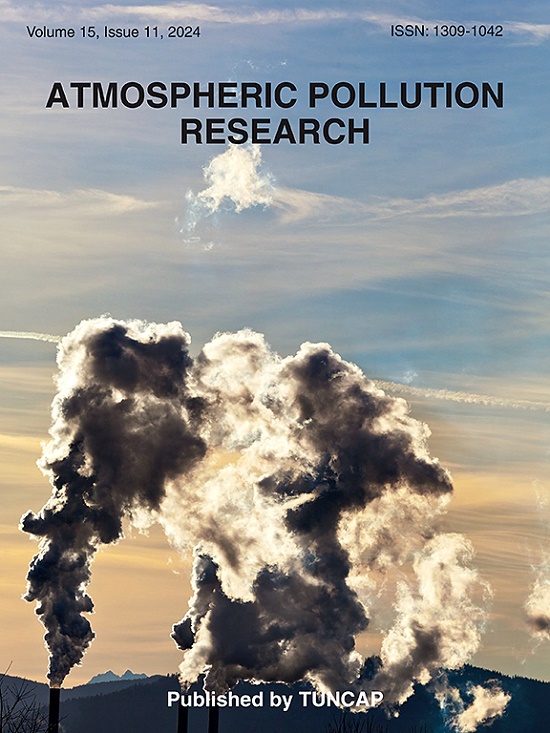利用表面活性剂雾化灭活空气传播病毒的环境消毒
IF 3.5
3区 环境科学与生态学
Q2 ENVIRONMENTAL SCIENCES
引用次数: 0
摘要
针对SARS-CoV-2等新病毒变体的出现,本研究的重点是提供检测和灭活空气传播病毒的有效替代方案。环境友好型表面活性剂的使用导致了一种有前途的技术的发展,这种技术高效地灭活室内生物气溶胶中的病毒,没有副产品,也没有健康风险。在受控的实验室条件(接触室)和试验室中模拟受感染性生物气溶胶污染的环境。建立了双琼脂层取样生物气溶胶按钮(SBAB-DAL),并验证了该按钮可用于从感染性生物气溶胶中回收病毒。研究了三种新型自定义表面活性剂(CS)(专利申请中):由苯扎氯铵(CSBC)配制的CS,基于吡啶(CSPB)的CS和由十六烷基三甲基氯化铵(CSCTAC)制备的CS,用于灭活噬菌体MS2 ATCC 15597-B1作为SARS-CoV-2替代品。用SBAB-DAL分析未灭活的病毒,以评估接触室的减少百分比(%减少)。在5分钟的接触时间内,CSBC、CSPB和CSCTAC的灭活率分别为99.810、99.986和99.500%。在10分钟的接触时间内,这三种表面活性剂的失活率高达99.999%。通过应用以气溶胶形式提供的定制表面活性剂处理,最高的失活(高达5 log10降低)具有很高的灭活潜力,可灭活环境病毒,如SARS-CoV-2。SBAB-DAL方法是一种简单有效的测试方法,可用于监测室内环境中作为初级病毒传播载体的感染性生物气溶胶。本文章由计算机程序翻译,如有差异,请以英文原文为准。

Environmental disinfection to inactivate airborne viruses by aerosolized surfactants
Providing effective alternatives for the detection and inactivation of airborne viruses is the focus of this research in response to the emergence of new variants of the virus, such as SARS-CoV-2. The use of environmentally friendly surfactants has led to the development of a promising technique with high efficacy for the inactivation of viruses in indoor bioaerosols, with no by-products and no health risks. Environments contaminated with infectious bioaerosols were simulated under controlled laboratory conditions (contact chamber) and in test rooms. The Sampling Bio-Aerosol Button by Double Agar Layer (SBAB-DAL) was developed and validated for virus recovery from infectious bioaerosols. Three new custom surfactants (CS) (patent pending): CS formulated with benzalkonium chloride (CSBC), CS based on pyridinium (CSPB) and CS prepared from cetyltrimethylammonium chloride (CSCTAC), were evaluated for inactivation of bacteriophage MS2 ATCC 15597-B1 as a surrogate for SARS-CoV-2. Non-inactivated viruses were analysed by SBAB-DAL to assess reduction percentages (% reduction) in contact chamber. CSBC, CSPB and CSCTAC were consistently able to inactivate up to 99.810, 99.986 and 99.500 % of the MS2 surrogate respectively in a 5-min contact time. The three surfactants were able to inactivate up to and 99.999 % over a 10-min contact time. The highest inactivation (up to 5 log10 reduction) by application of the customised surfactant treatments supplied in aerosol form has a high potential for the inactivation of environmental viruses such as SARS-CoV-2. The SBAB-DAL methodology is a simple and effective test that can be applied to the monitoring of infectious bioaerosols as vehicles of primary virus transmission in indoor environments.
求助全文
通过发布文献求助,成功后即可免费获取论文全文。
去求助
来源期刊

Atmospheric Pollution Research
ENVIRONMENTAL SCIENCES-
CiteScore
8.30
自引率
6.70%
发文量
256
审稿时长
36 days
期刊介绍:
Atmospheric Pollution Research (APR) is an international journal designed for the publication of articles on air pollution. Papers should present novel experimental results, theory and modeling of air pollution on local, regional, or global scales. Areas covered are research on inorganic, organic, and persistent organic air pollutants, air quality monitoring, air quality management, atmospheric dispersion and transport, air-surface (soil, water, and vegetation) exchange of pollutants, dry and wet deposition, indoor air quality, exposure assessment, health effects, satellite measurements, natural emissions, atmospheric chemistry, greenhouse gases, and effects on climate change.
 求助内容:
求助内容: 应助结果提醒方式:
应助结果提醒方式:


